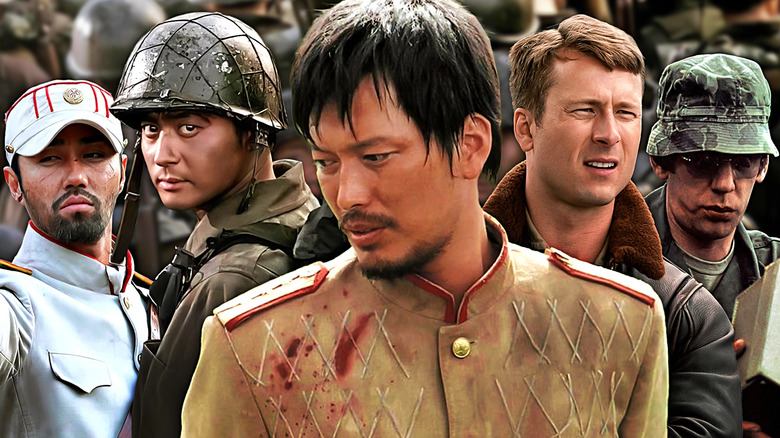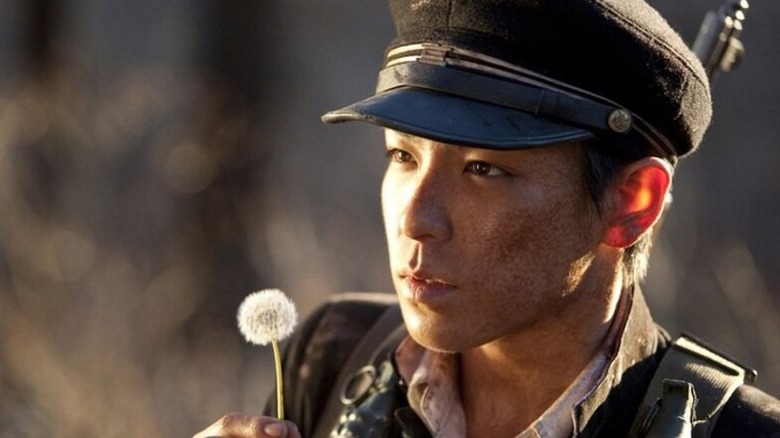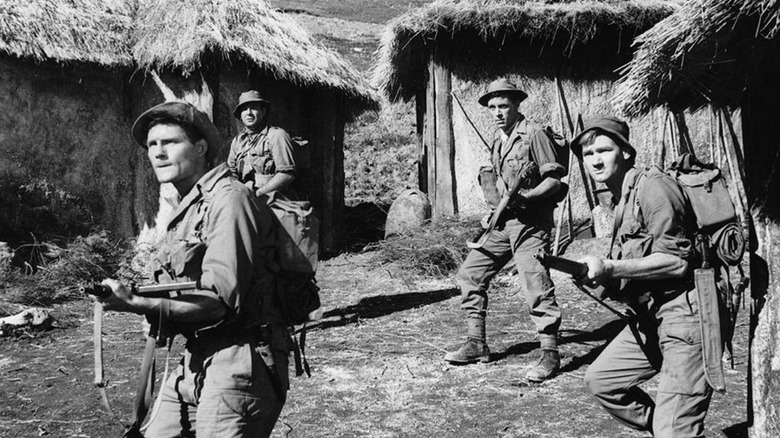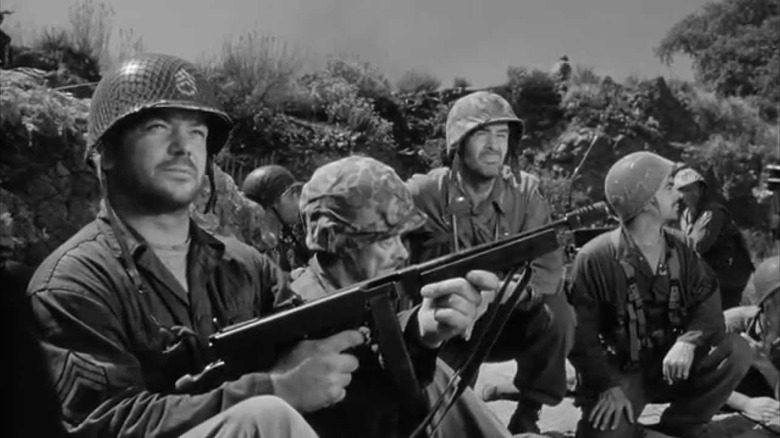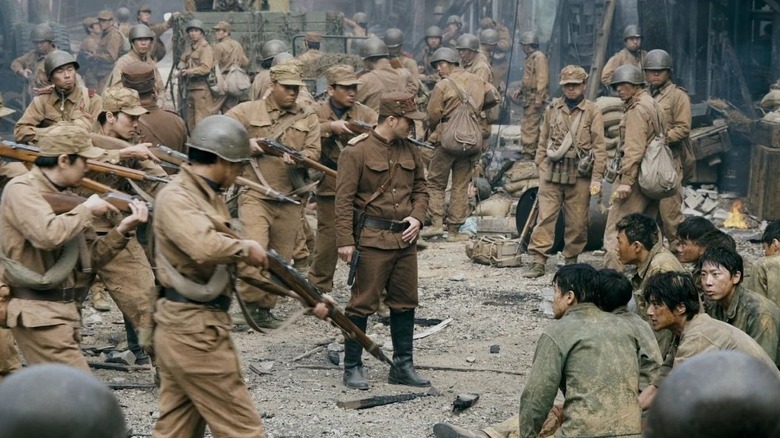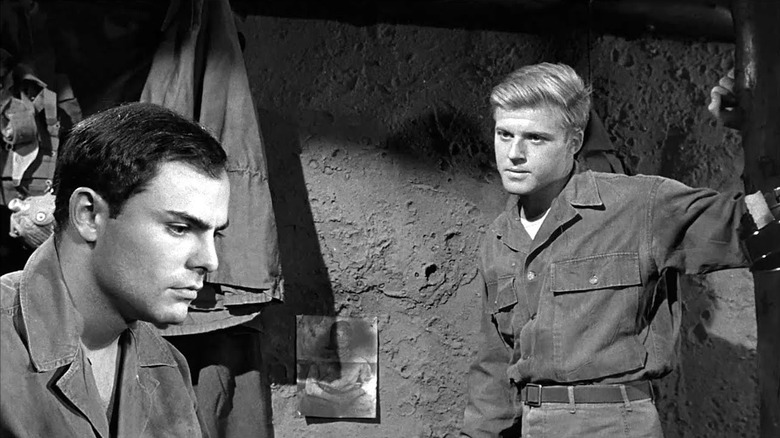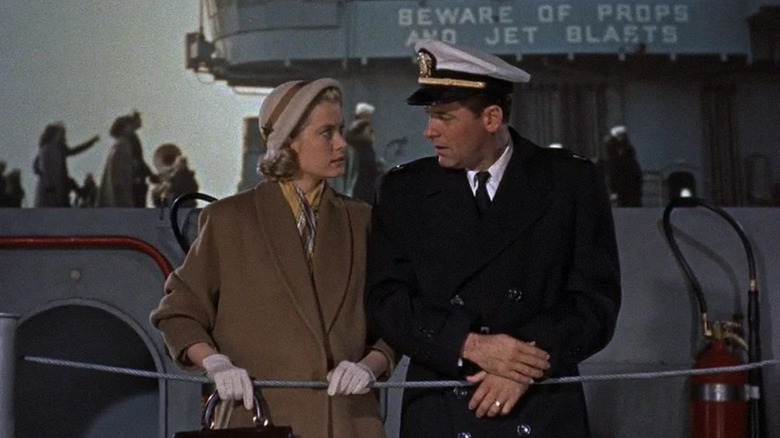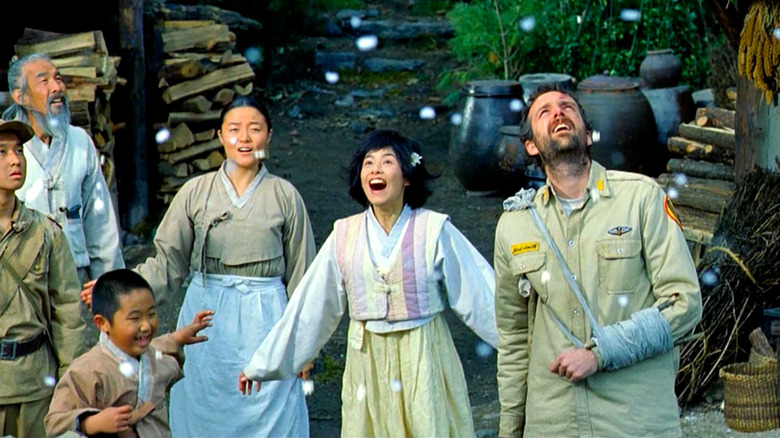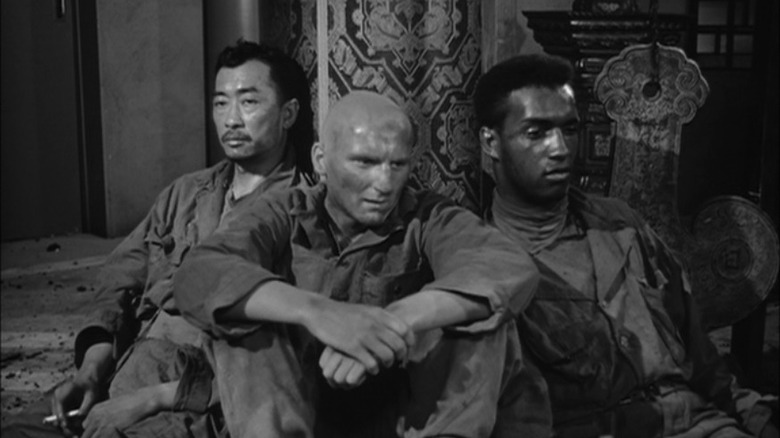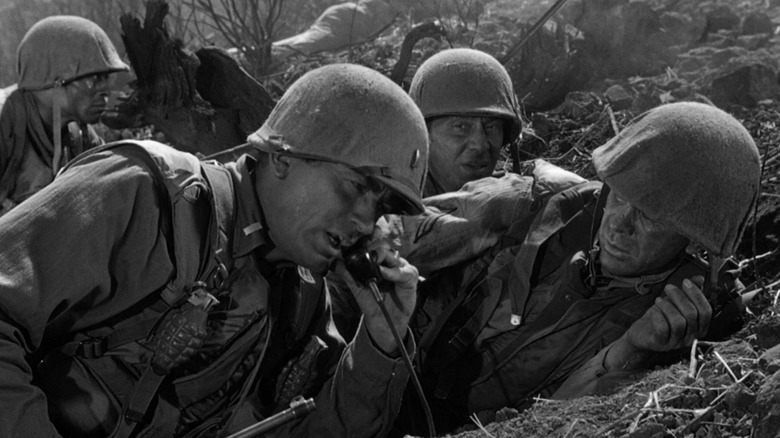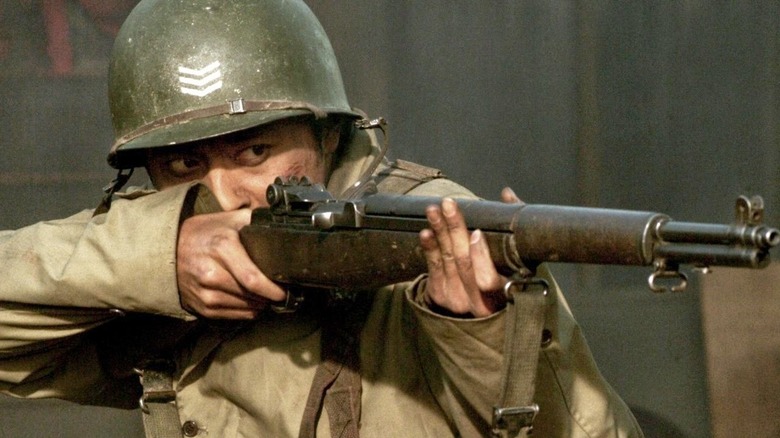The 12 Best Korean War Movies Ranked
One of the earliest global conflicts that followed World War II, the Korean War brought nascent Cold War tensions into a full-blown extended confrontation. Lasting from 1950 to 1953, the United States led an international coalition to defend South Korea from occupation from communist North Korea and China. The battle raged back and forth across the Korean peninsula, with Korea remaining firmly divided for generations after the ceasefire was signed. But for as pivotal as the Korean War was for worldwide political dynamics in the escalation of the Cold War, only a handful of Western movies have depicted it on-screen.
Of course, the specter of the Korean War continues to loom heavily for both Koreas, with tensions between the two nations ebbing and flowing for decades. Accordingly, both North and South Korea have provided their own perspectives on the war through the medium of film, and there are a number of movies from other international sources that each shine a light on this often-overlooked conflict. Here are the 12 best Korean War movies ranked.
71: Into the Fire
In the face of the initial North Korean attack in 1950, the South Korean and United Nations forces were pushed back into a defensive position, known as the Pusan Perimeter. The Battle of P'ohang-dong, crucial to the defense, is depicted in the 2010 South Korean movie "71: Into the Fire." As the perimeter runs the risk of being overwhelmed, 71 student volunteer soldiers take up arms to defend their school from the incoming North Korean military. Despite their lack of training and adequate supplies, the students valiantly put up a last stand behind their classmate Oh Jang-beom (Choi Seung-hyun).
Choi is better known under his stage name as the K-pop idol T.O.P., and stole the show in the second season of "Squid Game." The performer brings a lot of his natural charisma to "71: Into the Fire," albeit under much grittier and grounded circumstances, as the inexperienced Jang-beom. The production collaborated with the South Korean Ministry of Defense to lend a real sense of historical authenticity to the battle sequences. "71: Into the Fire" is a fantastic showcase of Choi Seung-hyun's more serious acting talent, and is based on a real pivotal battle that deserves more attention outside of Korea.
A Hill in Korea
Released under its original planned title "Hell in Korea" in the United States,1956's "A Hill in Korea" showcases the British perspective on the war. The movie follows a British squad in the midst of the Chinese military aiding the North Korean war effort and advancing down the Korean peninsula. Cut off from support, the small ensemble takes shelter in a remote temple located on a hill with only one accessible slope on foot. With the brunt of the Chinese army closing in on their position, this squad holds a defensive position as long as they can against the enemy.
"A Hill in Korea" is the first credited film role for Michael Caine, himself a Korean War veteran, who went on to have his own celebrated movie career. Caine's role is relatively small, only appearing as a British private, with established actors George Baker and Harry Andrews leading the young ensemble. Running at a tight 81 minutes, there are no frills to this war movie — just plenty of action in a familiar Alamo-esque setup. Providing a uniquely British perspective to the Korean War, "A Hill in Korea" is competently-made flick that's elevated by its promising young cast.
Men in War
The 1949 World War II novel "Day Without End" by Van Van Praag was repurposed into a Korean War movie in 1957 under the title "Men in War." The movie follows an American platoon cut off from outside support while being tasked with capturing a strategic hill held by the North Korean military. Led by Lieutenant Benson (Robert Ryan), the unit makes their way to their targeted location, encountering stiff enemy opposition along the way. Throughout their mission, the soldiers contemplate sitting out of the conflict as their cynical outlook continues to grow.
There is almost a neo-noir sensibility to "Men in War," from its growing sense of isolation experienced by its main characters to its moody black-and-white cinematography. To highlight that unease, the North Korean troops are rarely seen on-screen, almost presented as an invisible enemy that could strike at any time. Coupled with the cynical views of its main characters, this makes "Men in War" another early anti-war movie before they came into vogue with the Vietnam War. Atmospheric and bleak in its messaging, especially its melancholy ending, "Men in War" is another widely overlooked movie from its era.
The Front Line (2011)
The ongoing national trauma of a divided Korean peninsula is explored in the 2011 South Korean movie "The Front Line." The film opens in the early days of the war, with inexperienced soldier Kang Eun-pyo (Shin Ha-kyun) convinced the war will be brief, and showing compassion to North Korean prisoners-of-war. Three years of prolonged bloody fighting later, Kang has become a hardened soldier as the conflict intensifies to gain more territory before an armistice is signed. Kang has bittersweet encounters with North Korean troops, several of whom he recognizes, before a fierce showdown for the last push to seize territory before the borders are set.
What makes "The Front Line" stand out are the moments of shared humanity between North and South Koreans, opposing each other militarily, but retaining their kinship. Kang is a character irrevocably changed by his wartime service, but he still exchanges gifts and laughs with the prescribed enemy in those brief quiet instances. That cements the tragedy that these countrymen were pitted against each other by higher powers interested in territorial claims over human life. Kang is completely drained by having to kill those he'd rather trade jokes and smokes with, a feeling that spreads to the audience by the haunting closing shot.
War Hunt
One unsung but nonetheless prolific actor-director collaboration is between filmmaker Sydney Pollack and actor Robert Redford, with the two meeting as co-stars in 1962's "War Hunt." Directed and produced by Denis Sanders, the movie stars Redford as new recruit Roy Loomis and John Saxon as his murderous squadmate Raymond Endore. Endore is given free rein by his superiors to routinely infiltrate enemy lines at night and embark on brutal killing sprees. As the armistice looms, Loomis realizes Endore is out of control as he leaves for another nocturnal hunt with a Korean orphan he befriended named Charlie (Tommy Matsuda). Trying not to threaten the fragile peace talks, Loomis leads the squad to track down Endore and stop his latest murderous rampage.
Years before "The Dirty Dozen," it was "War Hunt" that introduced the idea of a serial killer prowling on 20th century battlefields. Saxon gives one of the most underrated performances of his career as the unhinged Endore while Redford brings many of the lead actor qualities that would inform his entire career. Fitting the premise, the movie is filmed in a moody black-and-white cinematography that feels like it only grows darker as it progresses. An early major role for Redford, with a fortuitous meeting with Pollack that steered both their careers, "War Hunt" is an offbeat and overlooked war flick.
The Bridges at Toko-Ri
James Michener's 1953 novel "The Bridges at Toko-Ri" was adapted into a movie of the same name the following year. The movie centers on American naval pilots during the Korean War, with World War II veteran aviator Harry Brubaker (William Holden) recalled to active duty to serve. Assigned to perform dangerous reconnaissance and bombing missions targeting North Korean bridges, Brubaker's nerve begins to fail him. As he prepares for his big mission to destroy the bridges at Toko-Ri, his beloved wife Nancy (Grace Kelly) grapples with the knowledge that she may lose her husband.
Given its close coordination with the U.S. Navy, "The Bridges at Toko-Ri" has the most authentic aerial sequences for a Korean War movie of its time. This is coupled with a more mature story than most wartime fare, with subtle anti-war messaging including America's involvement in the conflict and Brubaker's involuntary participation. The movie also boasts an early performance from Grace Kelly before she walked away from Hollywood, in a role demonstrating her well-rounded talent and wisdom beyond her young years. A surprisingly bleak war film considering its contemporary sensibilities, "The Bridges at Toko-Ri" juxtaposes duty with the lethal expectations of wartime service.
Welcome to Dongmakgol
Most movies covering the Korean War, with several notable exceptions, are dreary affairs capturing the misery of war and the cost to the civilians whose country was torn in half. The 2005 South Korean film "Welcome to Dongmakgol" offers a lighter alternative without losing sight of the human drama. The movie has American military pilot Neil Smith (Steve Taschler) crash near the secluded village of Dongmakgol, isolated deep in the mountains and unaware of the war consuming the country. Groups of North and South Korean soldiers wander separately into Dongmakgol, working together to protect this small pocket of peace from the devastating conflict.
"Welcome to Dongmakgol" is a Korean War comedy that's somehow even wackier than "M*A*S*H," occasionally veering into outright surrealism. But for all the gags, the war still haunts the soldiers finding refuge in Dongmakgol, informing their motivation to protect it from the outside fighting. This leads to a climax that is equal turns heartbreaking and triumphant, demonstrating the lengths the outsiders will go to keep this community safe. Funny without losing that sense of consequence, "Welcome to Dongmakgol" offers a refreshing perspective on the Korean War.
The Steel Helmet
American filmmaker Samuel Fuller was a director and screenwriter ahead of his time, often working outside of the major studio system to produce counterculture work. Drawing from his own experiences, Fuller made a number of war movies, including the first-ever Korean War movie, 1951's "The Steel Helmet." The movie follows Zack (Gene Evans), the sole survivor of his unit who takes care of an orphan that he nicknames Short Round (William Chun). As Zack and Short Round encounter other American soldiers while moving back to friendly territory, they find themselves engaged with a larger North Korean force.
A combat veteran himself, albeit of World War II, Fuller brings a lot of grounded realism to "The Steel Helmet" setting it apart from other genre movies of its time. It also tackles themes that were groundbreaking for its time, from racism in American society and the military and its depiction of combat-induced PTSD. In keeping with Fuller's other work, this is also the bleakest movie on this list, down to its abruptly grim ending. Released less than seven months after the actual war's outbreak, "The Steel Helmet" is a dark exploration of the futility and horrors of armed conflict.
Pork Chop Hill
The final year of the Korean War was especially tumultuous, with the international coalition fighting for South Korea regularly trading ground against the Chinese and North Korean opposition. The 1959 movie "Pork Chop Hill" takes place during these bloody final months, based on the historical novel by General S.L.A. Marshall. Gregory Peck stars as real-life U.S. Army officer Joe Clemons, who leads his unit to capture and defend a strategically insignificant hill from Chinese forces. Clemons and his unit dig in for a grueling fight while peace talks continue, with the hill as a bargaining chip for the negotiations.
Compared to most typical war movies being churned out by Hollywood in the '50s, "Pork Chop Hill" has more noticeable grit to it. There is an underlying cynicism to the movie compared to the usual gung-ho war hawk stance of many of its contemporaries. There's also the added quality in knowing that the movie was based on a true story, highlighting the actual sacrifice and dedication of the battle it depicts. A rugged movie that doesn't shy away from the frustrating politics of wartime, "Pork Chop Hill" gave Peck one of his most physically arduous roles.
Devotion (2022)
The exploits of real-life American aviators Jesse L. Brown and Tom Hudner are depicted in the 2022 Korean War movie "Devotion." Played respectively by Jonathan Majors and Glen Powell, Brown and Hudner are two fighter pilots paired together in the early days of the Cold War. Befriending each other, Brown insists Hudner just be there for him as a friend and colleague and let him deal with overt racism in the armed forces himself. As the Korean War breaks out, Brown and Hudner's squadron is deployed to the peninsula where the full measure of their heroism is tested.
Like the aviators they portray, the key appeal to "Devotion" is the great teamwork between on-screen duo Majors and Powell. Both actors are very much at the height of their charismatic powers and play off each other well, capturing the vulnerabilities of their characters beneath the military bravado. This a relatively straightforward biopic, though it knows when to bring the fire and fury with its requisite action sequences. A war movie made more compelling by the real-life people whose legacy it honors, "Devotion" is one of the most overlooked Korean War flicks to date.
M*A*S*H
The most well-known American depiction of the Korean War, largely because of the groundbreaking anti-war sitcom it inspired, is "M*A*S*H." Standing for mobile army surgical hospital, the 1970 movie loosely adapts Richard Hornberger's semi-autobiographical novel about his own experiences as an army surgeon in Korea during the war. Director Robert Altman provides a radically irreverent depiction of a M*A*S*H unit, led by gifted but rebellious army surgeons Hawkeye (Donald Sutherland) and Trapper John (Elliot Gould). In between saving lives, Hawkeye and Trapper John stay sane from the pressures of constant warfare by indulging openly in booze and sex while pulling pranks on the no-nonsense Frank Burns (Robert Duvall).
Though certainly set in the Korean War, "M*A*S*H" was retrofitted as a satirical commentary on the then-going Vietnam War. This is something that the subsequent television series doubled down on, fighting for the soul of contemporary America, and something the original author hated. These themes are prominent in the movie, and though it doesn't quite capture the distinct aspects of the Korean War, it does use it as an effective backdrop. "M*A*S*H" is a fantastic dark comedy that just happens to be set in Korea, with its themes as timeless and relevant to any armed conflict arena.
Taegukgi: The Brotherhood of War
The first major South Korean film to depict the Korean War comparable to contemporary Hollywood war movies was 2004's "Taegukgi: The Brotherhood of War." The movie follows brothers Lee Jin-tae (Jang Dong-gun) and Jin-seok (Won Bin) who are both drafted into the South Korean military when the war breaks out. Jin-tae takes on numerous dangerous missions in the hopes his growing prestige will result in Jin-seok's release from the army, only to be captured by the Chinese military. As Jin-seok battles fiercely to reunite with his brother, he learns a despondent Jin-tae has been conscripted into the North Korean army.
Both in terms of battlefield intensity and its narrative framing device, "Taegukgi" has several noticeable parallels to "Saving Private Ryan." The movie captures the uniquely traumatic and brutal aspects of the Korean War from the perspective of its main characters. With its depiction of how the lines of morality are blurred by combat and the horrors of war, the film set the bar for all subsequent Korean War movies. When it comes to movies that actually get to the heart of what the conflict was all about, none do it better than "Taegukgi: The Brotherhood of War."
